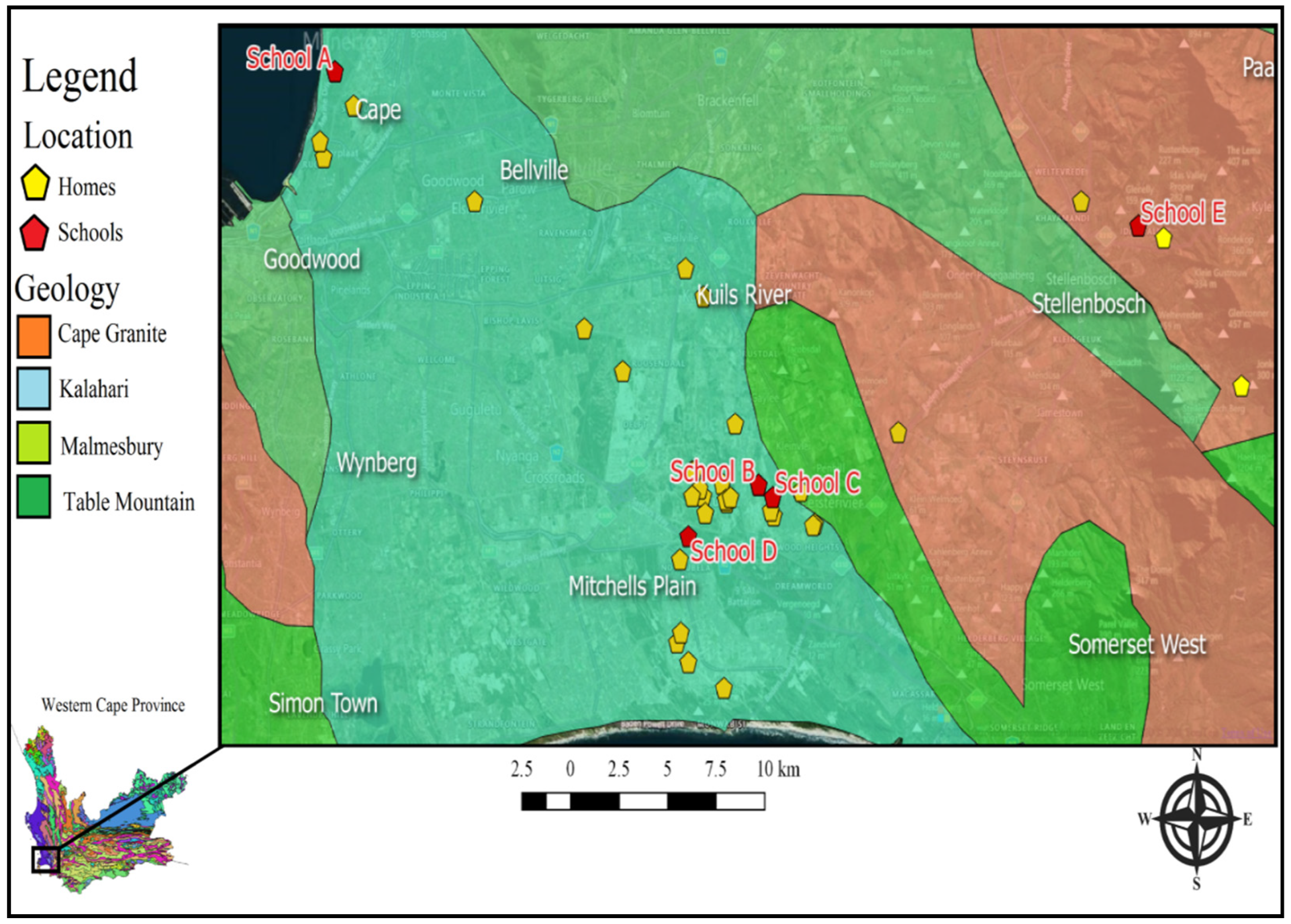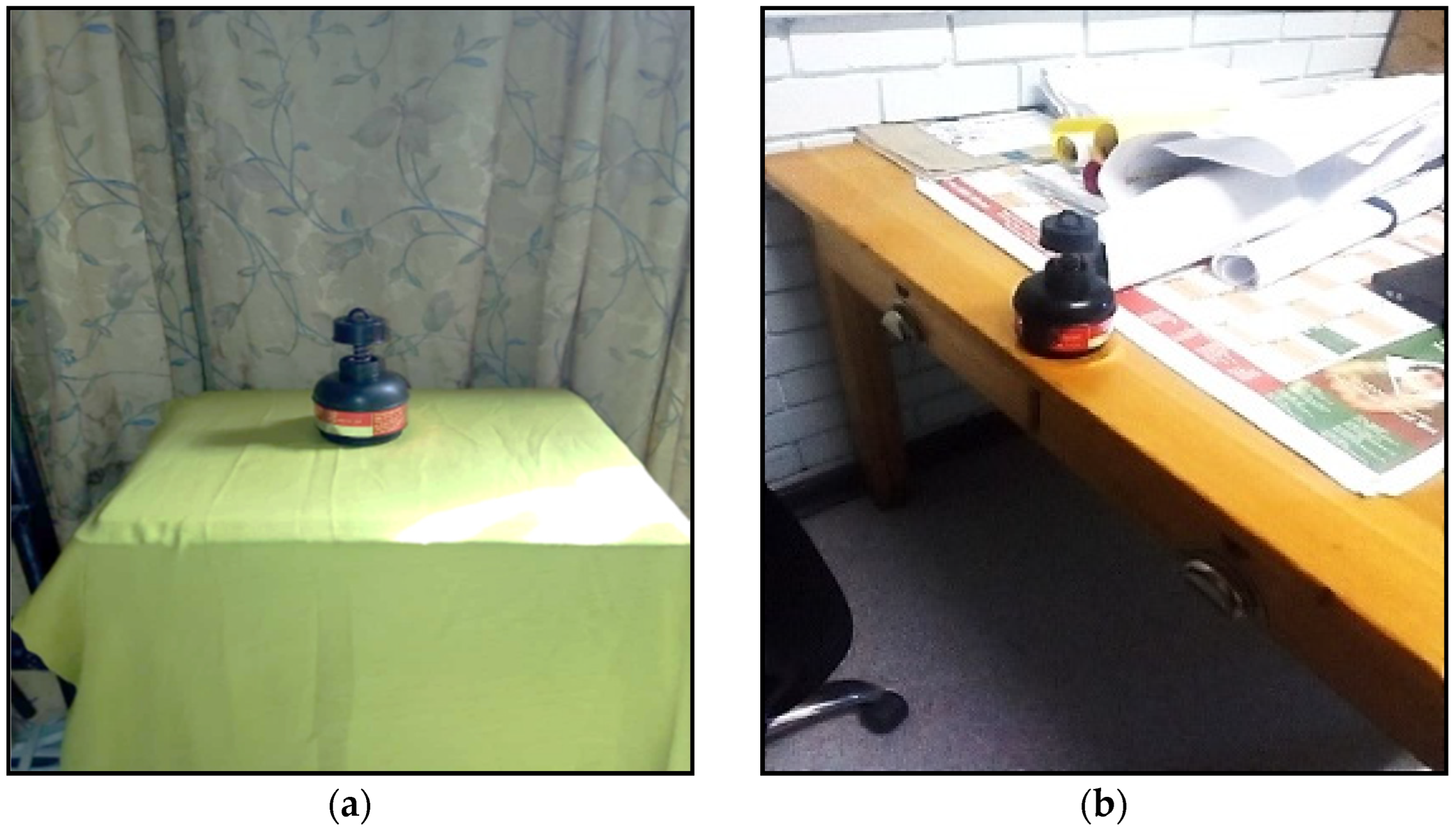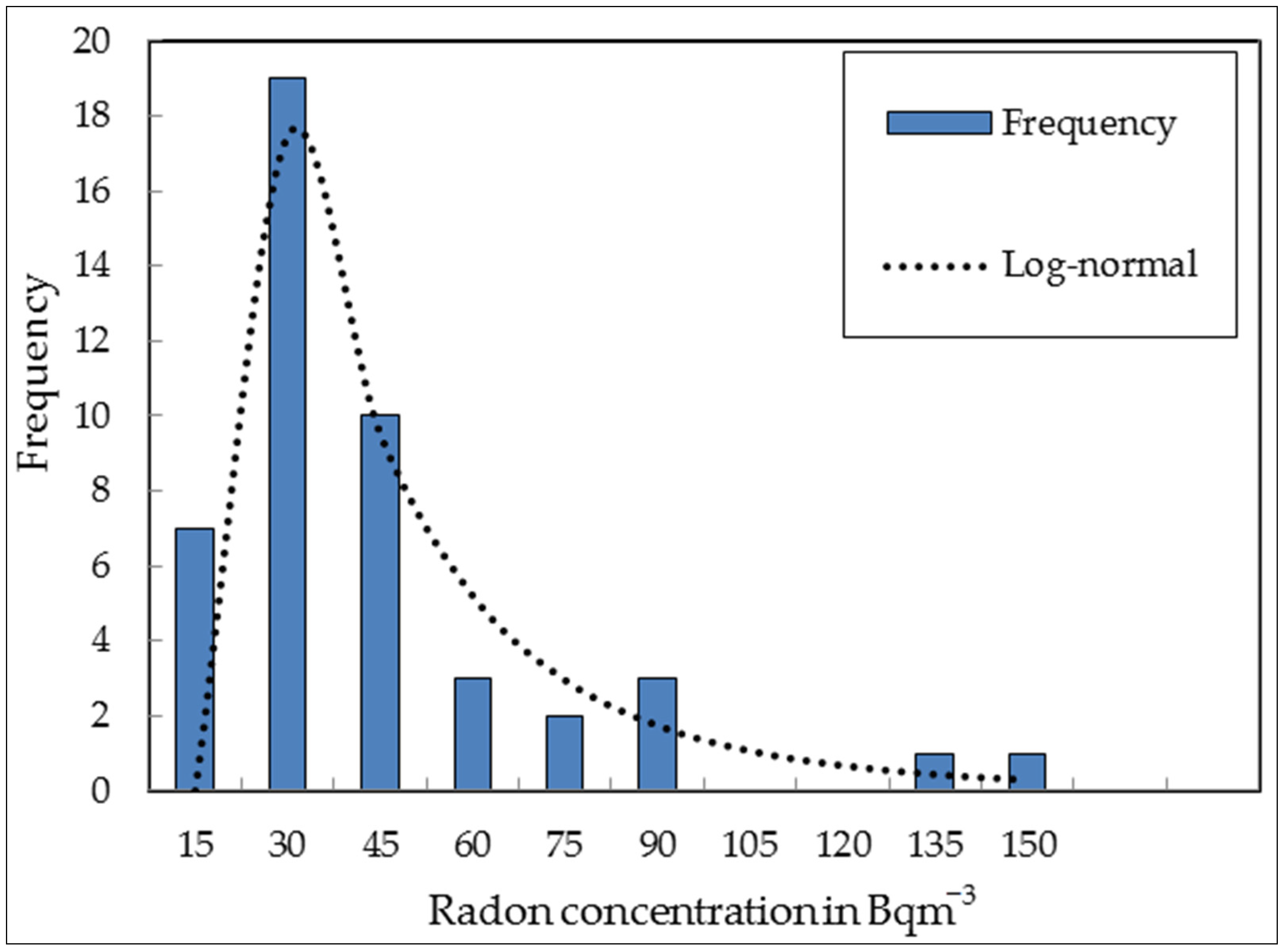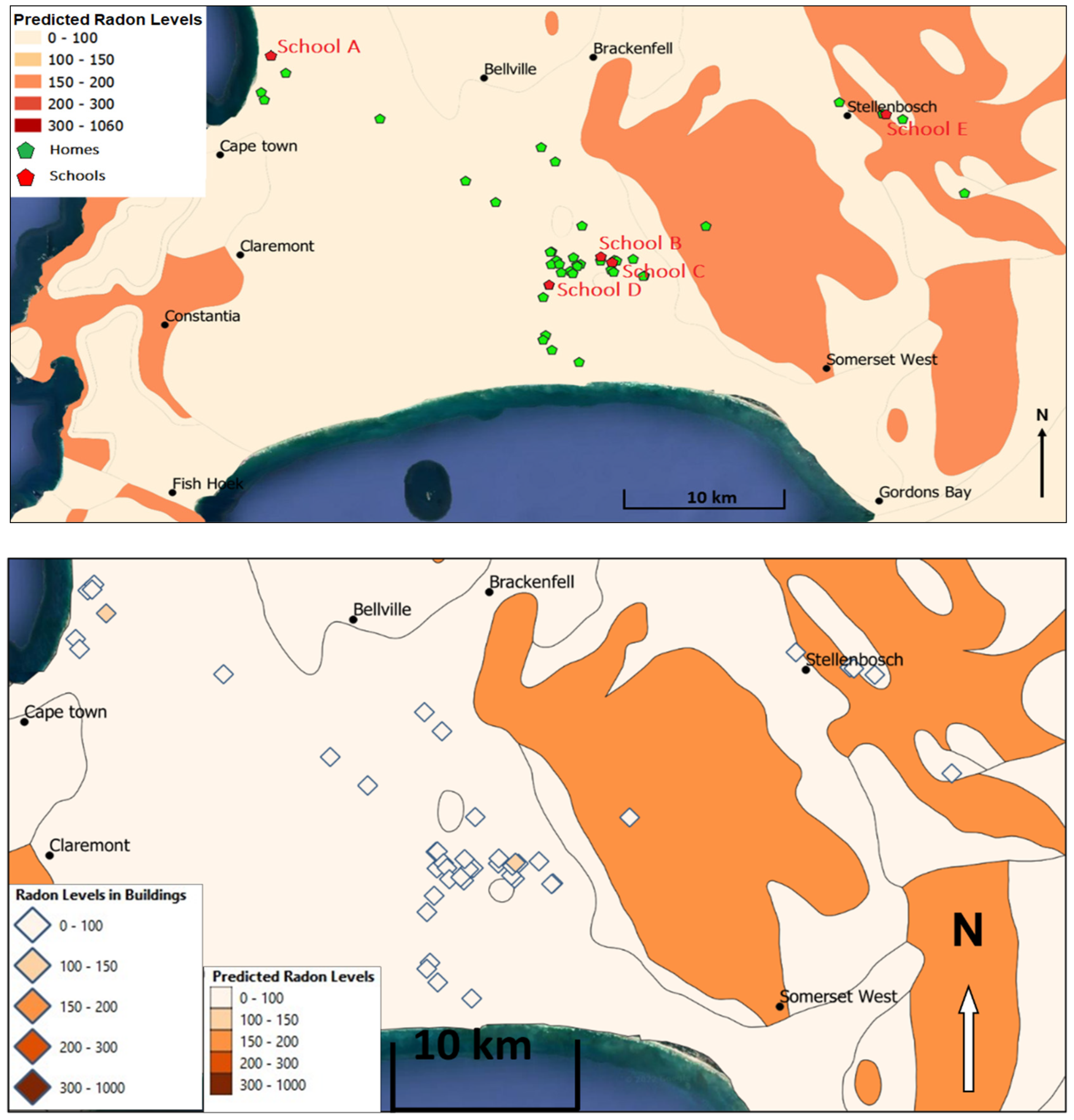Indoor Radon Levels in Homes and Schools in the Western Cape, South Africa—Results from a Schools Science Outreach Initiative and Corresponding Model Predictions
Abstract
1. Introduction
2. Materials and Methods
2.1. Study Design
2.2. Study Area
2.3. Organization of the Outreach
2.4. Questionnaire
2.5. Radon Measurements
2.6. Analysis
2.7. Data Processing
3. Results
4. Modeling Indoor Radon Concentrations
5. Conclusions
Author Contributions
Funding
Institutional Review Board Statement
Informed Consent Statement
Data Availability Statement
Conflicts of Interest
References
- Šenitková, I.J.; Šál, J. Indoor radon concentration related to different radon areas and indoor radon prediction. Earth Environ. Sci. 2017, 95, 022053. [Google Scholar] [CrossRef]
- Sherafata, S.; Mansoura, S.N.; Mosaferib, M.; Aminisanid, N.; Yousefie, Z.; Malekif, S. First indoor radon mapping and assessment excess lifetime cancer risk in Iran. MethodsX 2019, 6, 2205–2216. [Google Scholar] [CrossRef]
- US Environmental Protection Agency. Radon Health Risks; EPA: Washington, DC, USA, 2003.
- Yarahmadi, M.; Shahsavani, A.; Mahmoudian, H.M.; Shamsedini, N.; Rastkari, N.; Kermani, M. Estimation of the residential radon levels and the annual effective dose in dwellings of Shiraz, Iran, in 2015. Electron. Physician 2008, 8, 2497–2505. [Google Scholar] [CrossRef] [PubMed]
- Wahyudi, I.; Winarni, D.; Wiyono, M. Indoor Radon measurements in Madura dwellings. IOP Conf. Ser. J. Phys. Conf. Ser. 2020, 1436, 012012. [Google Scholar]
- Barros, N.; Steck, D.J.; Field, R.W. Utility of short-term basement screening radon measurements to predict year-long residential radon concentrations on upper floors. Radiat. Prot. Dosim. 2016, 171, 405–413. [Google Scholar] [CrossRef] [PubMed]
- European Union. Council Directive 2013/51/Euratom of 22 October 2013 Laying Down Requirements for the Protection of the Health of the General Public with Regard to Radioactive Substances in Water Intended for Human Consumption; European Union: Brussels, Belgium, 2013. [Google Scholar]
- La Verde, G.; D’Avino, V.; Sabbarese, C.; Ambrosino, F.; Roca, V.; Raulo, A.; Pugliese, M. Radiation Protection Legislation and Sustainable Development of a Rural Green Tuff Village of Ischia Island. Sustainability 2020, 12, 8374. [Google Scholar] [CrossRef]
- Maheso, A.M. Radon Levels in South African homes—Design Elements for a National Survey and Initial Results from Directed Sampling. Master’s Thesis, University of Stellenbosch, Western Cape, South Africa, 1 April 2021. [Google Scholar]
- Zubair, M.; Kassar, A.A.; Hamouda Ishag, A.M.; Ansari, A.A.; Hussain Aljassmi, A.A. Radiation Measurement in the University of Sharjah. Int. J. Magn. Nucl. Sci. 2016, 5, 33–38. [Google Scholar]
- World Health Organization. WHO Handbook on Indoor Radon; WHO: Geneva, Switzerland, 2009.
- Bezuidenhout, J. Estimating indoor radon concentrations based on the uranium content of geological units in South Africa. J. Environ. Radioact. 2021, 234, 106647. [Google Scholar] [CrossRef] [PubMed]
- Lindsay, R.; Newman, R.T.; Speelman, W.J. A study of airborne radon levels in Paarl houses (South Africa) and associated source terms, using electret ion chambers and gamma-ray spectrometry. Appl. Radiat. Isot. 2008, 66, 1611–1614. [Google Scholar] [CrossRef] [PubMed]






| Variables | N | Mean (SD) | Maximum | |
|---|---|---|---|---|
| Building type | Homes 1 | 35 | 36 ± 26 | 127 |
| Schools 2 | 14 | 38 ± 36 | 144 | |
| Age of building | Old (>20 years) | 22 | 39 ± 34 | 144 |
| Newly built (<20 years) | 21 | 24 ± 26 | 85 | |
| Not stated | 6 | 37 ± 16 | 70 | |
| Floors in the building | Basement | 1 | 31 ± 2 | - |
| Ground floor | 46 | 37 ± 29 | 144 | |
| 2nd Floor and up | 2 | 25 ± 16 | 37 | |
| Building materials | Brick | 43 | 36 ± 29 | 144 |
| Shacks | 4 | 37 ± 19 | 60 | |
| Others 3 | 2 | 52 ± 51 | 88 | |
| Flooring type | Carpets | 4 | 41 ± 30 | 89 |
| Concrete | 7 | 27 ± 16 | 60 | |
| PVC 4 | 5 | 36 ± 29 | 82 | |
| Tiles | 27 | 37 ± 32 | 144 | |
| Wood | 6 | 45 ± 26 | 88 | |
| Overall statistics | 49 | 37 ± 29 | 144 |
Disclaimer/Publisher’s Note: The statements, opinions and data contained in all publications are solely those of the individual author(s) and contributor(s) and not of MDPI and/or the editor(s). MDPI and/or the editor(s) disclaim responsibility for any injury to people or property resulting from any ideas, methods, instructions or products referred to in the content. |
© 2023 by the authors. Licensee MDPI, Basel, Switzerland. This article is an open access article distributed under the terms and conditions of the Creative Commons Attribution (CC BY) license (https://creativecommons.org/licenses/by/4.0/).
Share and Cite
Maheso, A.M.; Bezuidenhout, J.; Newman, R.T. Indoor Radon Levels in Homes and Schools in the Western Cape, South Africa—Results from a Schools Science Outreach Initiative and Corresponding Model Predictions. Int. J. Environ. Res. Public Health 2023, 20, 1350. https://doi.org/10.3390/ijerph20021350
Maheso AM, Bezuidenhout J, Newman RT. Indoor Radon Levels in Homes and Schools in the Western Cape, South Africa—Results from a Schools Science Outreach Initiative and Corresponding Model Predictions. International Journal of Environmental Research and Public Health. 2023; 20(2):1350. https://doi.org/10.3390/ijerph20021350
Chicago/Turabian StyleMaheso, Abbey Matimba, Jacques Bezuidenhout, and Richard Thomas Newman. 2023. "Indoor Radon Levels in Homes and Schools in the Western Cape, South Africa—Results from a Schools Science Outreach Initiative and Corresponding Model Predictions" International Journal of Environmental Research and Public Health 20, no. 2: 1350. https://doi.org/10.3390/ijerph20021350
APA StyleMaheso, A. M., Bezuidenhout, J., & Newman, R. T. (2023). Indoor Radon Levels in Homes and Schools in the Western Cape, South Africa—Results from a Schools Science Outreach Initiative and Corresponding Model Predictions. International Journal of Environmental Research and Public Health, 20(2), 1350. https://doi.org/10.3390/ijerph20021350






